
The ancient Egyptians believed that a soul was made up of many parts. In addition to these components of the soul, there was the human body.
An obelisk is a tall, four-sided, narrow tapering monument which ends in a pyramid-like shape or pyramidion at the top. Originally they were called tekhenu by their builders, the Ancient Egyptians. The Greeks who saw them used the Greek term obeliskos to describe them, and this word passed into Latin and ultimately English. Ancient obelisks are monolithic; that is, they consist of a single stone. Most modern obelisks are made of several stones.
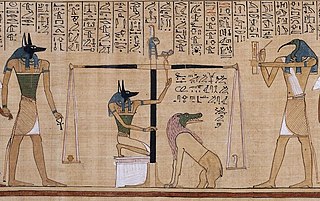
The Book of the Dead is an ancient Egyptian funerary text generally written on papyrus and used from the beginning of the New Kingdom to around 50 BCE. The original Egyptian name for the text, transliterated rw nw prt m hrw, is translated as Book of Coming Forth by Day or Book of Emerging Forth into the Light. "Book" is the closest term to describe the loose collection of texts consisting of a number of magic spells intended to assist a dead person's journey through the Duat, or underworld, and into the afterlife and written by many priests over a period of about 1,000 years.

Luxor is a city in Upper (southern) Egypt and the capital of Luxor Governorate. The population numbers 506,535, with an area of approximately 417 square kilometres (161 sq mi).

The Mummy is a 1932 American pre-Code romantic horror film directed by Karl Freund. The screenplay by John L. Balderston was from a story by Nina Wilcox Putnam and Richard Schayer. Released by Universal Studios, the film stars Boris Karloff, Zita Johann, David Manners, Edward Van Sloan and Arthur Byron. The film is about an ancient Egyptian mummy named Imhotep who is discovered by a team of archaeologists and inadvertently brought back to life through a magic scroll. Disguised as a modern Egyptian, the mummy searches for his lost love, whom he believes has been reincarnated into a modern girl.
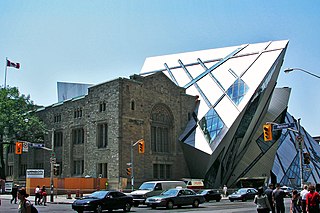
The Royal Ontario Museum is a museum of art, world culture and natural history in Toronto, Ontario, Canada. It is one of the largest museums in North America and the largest in Canada. It attracts more than one million visitors every year, making the ROM the most-visited museum in Canada. The museum is north of Queen's Park, in the University of Toronto district, with its main entrance on Bloor Street West. Museum subway station is named after the ROM and, since a 2008 renovation, is decorated to resemble the institution's collection.

Djer is considered the third pharaoh of the First Dynasty of ancient Egypt in current Egyptology. He lived around the mid-thirty-first century BC and reigned for c. 40 years. A mummified forearm of Djer or his wife was discovered by Flinders Petrie, but was discarded by Émile Brugsch.

The ancient Egyptians had an elaborate set of funerary practices that they believed were necessary to ensure their immortality after death. These rituals and protocols included mummifying the body, casting magic spells, and burial with specific grave goods thought to be needed in the Egyptian afterlife.

Luxor Museum is an archaeological museum in Luxor, Egypt. It stands on the corniche, overlooking the west bank of the River Nile.

The Papyrus of Ani is a papyrus manuscript in the form of a scroll with cursive hieroglyphs and color illustrations that was created c. 1250 BCE, during the nineteenth dynasty of the New Kingdom of ancient Egypt. Egyptians compiled an individualized book for certain people upon their death, called the Book of Going Forth by Day, more commonly known as the Book of the Dead, typically containing declarations and spells to help the deceased in their afterlife. The Papyrus of Ani is the manuscript compiled for the Theban scribe Ani.

The Joseph Smith Papyri (JSP) are Egyptian funerary papyrus fragments from ancient Thebes dated between 300 to 100 BC which, along with four mummies, were once owned by Joseph Smith, the founder of the Latter Day Saint movement. Joseph Smith said that the papyrus contained the records of the ancient patriarchs Abraham and Joseph. In 1842, Joseph Smith published what he said was the first part of the translation of the Book of Abraham. The Book of Joseph is not known to have been translated by Smith.
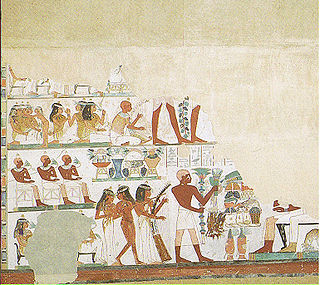
The Theban Tomb TT52 is located in Sheikh Abd el-Qurna, part of the Theban Necropolis, on the west bank of the Nile, opposite to Luxor. It is the burial place of the Ancient Egyptian official, Nakht.
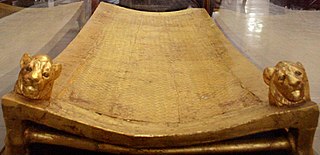
Exhibitions of artifacts from the tomb of Tutankhamun have been held at museums in several countries, notably the United Kingdom, Soviet Union, United States, Canada, Japan, and France etc.

Setau was the Viceroy of Kush in the second half of Ramesses II's reign. Contemporary records show that Setau served in this position from Year 38 until at least Year 63 of Ramesses II's reign. Setau was "a graduate of the royal school" and already enjoyed an impressive record of royal service which is detailed in a long autobiographical inscription carved at Wadi es-Sebua. The temple of Wadi es-Sebua was built for Ramesses II by Setau around 1236 BC or Year 44 of this pharaoh's reign. Eleven of his stela, now in the Cairo Museum, were found in the courtyard of this temple and make it possible to establish his career and understand the precise duties of a viceroy. Setau states:
I was one whom his Lord caused to instructed....as a ward of the palace. I grew up in the royal abode when I was a youth...I was provided for with bread and beer from all the royal meals. I came forth as a scribe from the school, I was appointed to be Chief Scribe of the Vizier; I assessed the whole land with a scroll. A task I being equal to the task.
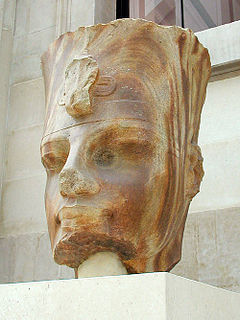
The colossal quartzite statue of Amenhotep III is an Ancient Egyptian sculpture dating from the 18th Dynasty. It was found in the massive mortuary temple of the pharaoh Amenhotep III on the West Bank of the River Nile at Thebes (Luxor) in Egypt. Only the head of the broken colossal statue survives. It is part of the British Museum's Department of Ancient Egypt and Sudan collection.

Djedmaatesankh was an Egyptian woman from the city then known as Waset who died in the middle of the 9th century B.C. She was an ordinary middle-class woman and musician. Her cartonnage coffin is thought to have been buried on the west bank of the Nile about 2,850 years ago. The coffin and mummy of the lady Djedmaatesankh are part of the permanent collection of the Royal Ontario Museum in the Galleries of Africa: Egypt. The coffin was collected and brought to the ROM by Dr. Charles Trick Currelly, the Museum's first director, in the early 20th century. Notably, the cartonnage of Djedmaatesankh is one of the best preserved of its period.

The mask of Tutankhamun is a gold mask of the 18th-dynasty ancient Egyptian Pharaoh Tutankhamun. It was discovered by Howard Carter in 1925 in tomb KV62 in the Valley of the Kings, and is now housed in the Egyptian Museum in Cairo. The mask is one of the best-known works of art in the world.
The Art Institute of Chicago contains a Book of the Dead scroll, an Ancient Egyptian papyrus depicting funerary spells. This scroll of funerary spells serves as a protection from "Second Death". In ancient Egyptian spiritual practice, the term "Second Death" refers to the phenomenon of the body permanently separating from the soul. The Book of the Dead scroll is made of papyrus, a material made of reed plants cultivated on marshy plantations, which is then cut into strips and left to dry in horizontal and vertical rows. The scroll also contains pigments used to inscribe the funerary spells.
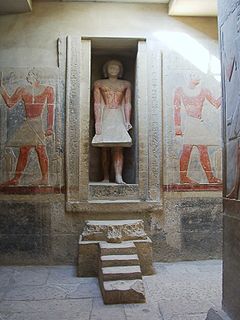
Ancient Egyptian afterlife beliefs were centered around a variety of complex rituals that were influenced by many aspects of Egyptian culture. Religion was a major contributor, since it was an important social practice that bound all Egyptians together. For instance, many of the Egyptian gods played roles in guiding the souls of the dead through the afterlife. With the evolution of writing, religious ideals were recorded and quickly spread throughout the Egyptian community. The solidification and commencement of these doctrines were formed in the creation of afterlife texts which illustrated and explained what the dead would need to know in order to complete the journey safely.

The Theban Tomb known as MMA 57 is located in Deir el-Bahari. It forms part of the Theban Necropolis, situated on the west bank of the Nile opposite Luxor. The tomb is likely the burial place of the Ancient Egyptian Harwa.




















